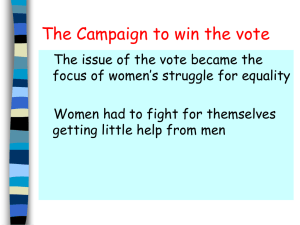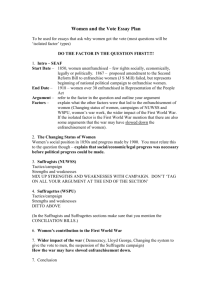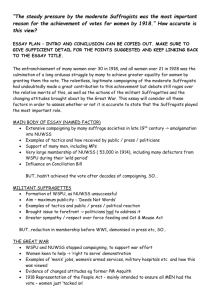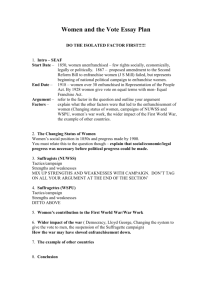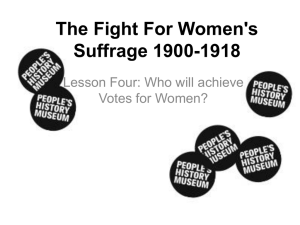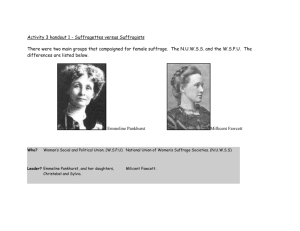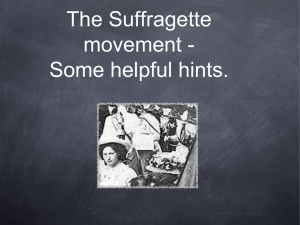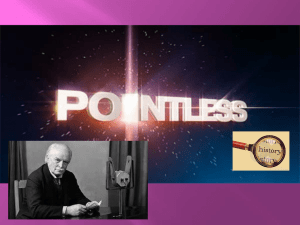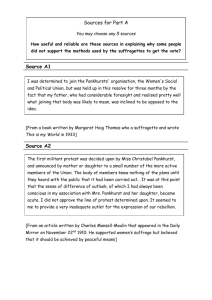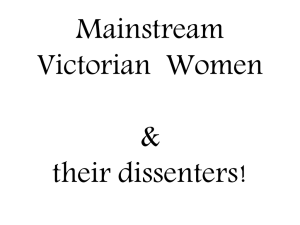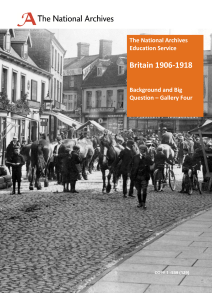File
advertisement
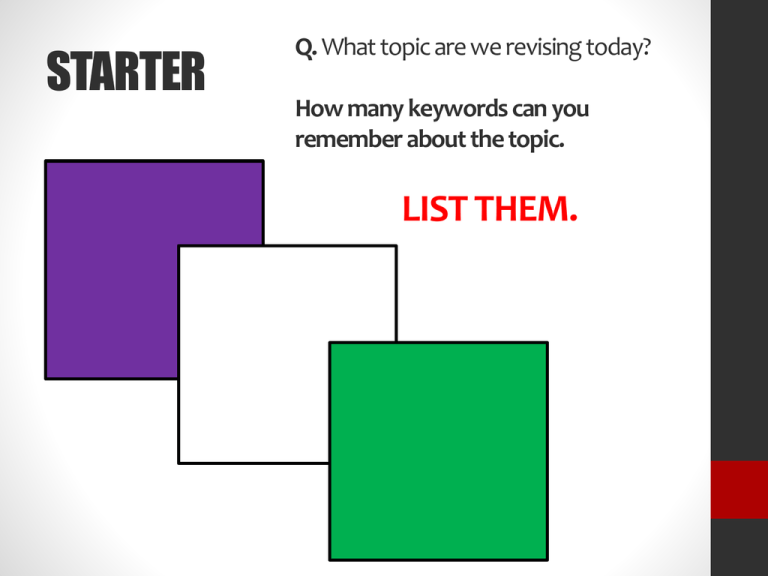
STARTER Q. What topic are we revising today? How many keywords can you remember about the topic. LIST THEM. WALT: How the Vote for Women was won. WILFs: 4 - Describe the work of the WSPU and NUWSS 5 - Explain how the vote was won. 6 - Compare the WSPU and NUWSS tactics. 7 - Evaluate the impact of WW1. What do I need to know? THINK – PAIR – SHARE Think what this image might be about? Who wrote it? How do you know? What’s the purpose of the poster? TASK: Flash Cards • Create your own flash cards for the topic of your choice – Create a card with a single word on it, you will test each other verbally to see if you can fully explain the word. On the reverse you can write bullet points to help… 1914 TASK: Spider Diagram • Create a Spider Diagram of a topic of your choice – Put your topic in the centre and have information coming from each leg. Think about factors involved. Suffragists TASK: QQT / Find-the-Fiction. • Create a Quiz Quiz Trade Cards of a topic of your choice – This is a Quiz, write down a question on the front and an answer on the back. Ask your table your questions and Swap cards! • Create a Find-the-Fiction card – Write down TWO false statements and ONE truthful statement about a topic. Ask your table your statement once you are done! QQT - Q Who was Emmeline Pankhurst? A – She was the leader of the WSPU (Suffragettes). F-T-F - Emmeline Pankhurst was the leader of the WSPU - Emmeline Pankhurst was the leader of the NUWSS - Emmeline Pankhurst was Prime Minister in 1914 TASK: Flow Charts Create flow charts for the following. How the Vote was won for the women. Remember there isn’t only ONE cause. There is one that might be more important though. 1868 NUWSS WSPU Cat & Mouse Act Asquith… 1910 1868 First ever public meeting on women's suffrage held in Manchester. 1870 First Women's Suffrage bill rejected by Parliament. 1897 NUWSS formed. 1903 WSPU formed. 1905 Christabel Pankhurst and Annie Kenney imprisoned for interrupting a meeting of the Liberal party. 1906 First women's march to lobby Parliament organised by the WSPU. 1907 WFL formed after a disagreement within the WSPU. 1908 Asquith becomes Prime Minister. 1909 Agitation increases including window breaking and the first hunger strike by Marion Dunlop. Forced feeding of other hunger strikers follows. 1913 Cat and Mouse Act introduced. 1913 Emily Davison killed at the Epsom Derby. 1914 Outbreak of WWI. Militant activities suspended. 1918 Representation of the People Act gives votes to women over the age of 30 who are also householders, the wives of householders, owners of property worth more than £5 or university graduates. 1919 Lady Astor becomes the first female MP. 1928 The Equal Franchise Act grants the vote to all women over the age of 21. November 1910 was a turning point in the campaign. The Prime Minister promised to change the law so that women had the right to vote. 18 November 1910, 300 women went to Parliament to protest. They were beaten up by police who had been ordered by the government to frighten and humiliate the women. One woman died… From 1910 the suffragette campaign became more MILITANT. Hundreds would risk a prison sentence. Street lamps were broken. Thirteen pictures were hacked in the Manchester Art Gallery. Houses were set on fire. Bombs were placed near the Bank of England. As part of your revision, think about the arguments and facts you would use to explain: What the arguments were for and against female suffrage. How effective the activities of the suffragists and the suffragettes were. Why some women were given the vote in 1918. Source A – Importance of Sylvia Pankhurst In June 1914, she famously took a delegation of working class women to lobby Prime Minister Asquith who did not think that working class women were intelligent enough to have the vote. This proved to Asquith that working class women were intelligent enough to vote. Source C – Millicent Fawcett (NUWSS) talking about the importance of the WSPU. “In my opinion, far from having injured the movement, they have done more during the last 12 months to bring it within the region of practical politics than we have been able to accomplish”. Source D – Historian on the Suffragettes “After November 1911 the position is much more doubtful. Militancy was becoming more extreme and strong antagonism was being aroused. The public could hardly be expected to approve of arson.” Source B – Importance of the NUWSS The NUWSS was established in 1897 by Millicent Fawcett and its members were known as Suffragists. The NUWSS hoped to persuade politicians to give them the right to vote and undertook a peaceful campaign. Some of their tactics included petitions, distributing leaflets and organised meetings. They were the first organised group of women to begin campaigning for female suffrage. They were responsible for persuading a number of MPs to back their cause. Fawcett believed that if the organisation was seen to be intelligent, polite and law-abiding then women would prove themselves responsible enough to participate fully in politics. Source E – Image of Suffragists campaigning in 1900. 1 2 Y B 8 3 4 6 7 5 G R
